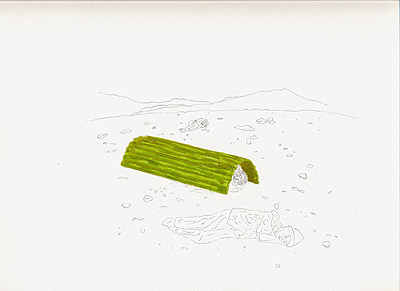 Shelter, 2003 drawing, 41 x 47 cm © ProLitteris Ives Maes Recyclable Refugee Camp - Project Brigitte Weiss Gallery presents the first installation of "Recyclable Refugee Camp", a project by Belgian artist Ives Maes (born 1976). This R.R.C. - built in conformity with the regulations of the U.N. High Commissioner for Refugees - consists of structures such as living units, a multifunctional tent and latrines; all easily transportable and with a relatively low production cost. What is more is the fact that everything is made of biodegradable and recyclable materials, thus reducing the environmental damage caused by such a temporary station of people on the run. Eventually, most of this camp will disintegrate after a few years. Along with these basic components, the artist plans the development of additional elements such as electricity-producing devices that make use of natural resources, relaxation spaces and a kindergarten with toys and educational instalments. The purpose is to improve the inhabitant's psychological well-being, a function that is also notably present in the other pieces by their forms which are derived from art historical references: the living unit for example takes its form from African huts or Mario Merz's dome-like sculptures, and the water well resembles Michelangelo Pistoletto's Cinqo Pozzi. Ives Maes developed his R.R.C. out of the artistic need to create an artwork that would be absolutely ethical in nature, well aware of the fact that this claim to hyper-ethicality would fail. Maes began rethinking the ideas of social sculpture and politically engaged art at the instigation of the Progretto Arte manifesto and the concept of Unidee (The University of Ideas) by Pistoletto. R.R.C. was proposed to Pistoletto's Cittadellarte-Fondazione (Biella, Italy) earlier this year and triggered an intense debate there. Because Maes culminates epistemological tools used in discussions on contemporary art - like interdisciplinary practice, aestheticism and the position of the artist in the "real" world - mixed with a set that befits academic discourses on global economy and politics, sociology and ecological concerns. This redundancy makes the work shift to an ideal and utopian construction, though it gleefully retains its perception of pragmatism. The project thus arouses disturbance in the viewer's mind and raises questions about the terminology uttered by self-declared socially aware artists. Moreover, in a clever way the R.R.C. lays bare their ambiguous position in trying to keep the core of their oeuvre deeply grounded in everyday life, while at the same time engaging in the introvert and comforting system we call the art world. Another issue the R.R.C. raises, is the determination of a great divide between the utopian dream and reality. Maes truly beliefs in art's function to offer a dream, or to provoke questions that point out the way to a partial realisation of it. Nevertheless, he is less credulous about a too far-fetched utopianism that ultimately will become ideological, thus destroying creativity. It is also his concern that some artists dealing with political issues get stuck in a certain amateurism by their oft mentioned crossing of the boundaries of art into the fields of sociology, ecology, biology or other sciences. In this position their work will be read as naive dilettantism or uninteresting art, depending from what side it will be looked at. One notices a hesitation from Maes's part to fully agree with the contemporary urge to assimilate the art world with the "real". What others may call art's ivory tower, is for Maes a privileged position to creatively and often wittily pose critique not only on aspects of life at large, but also on the art society as well. In his eyes the expansion of its frontiers does not have to mean that those will be abolished in the end at all. A thesis he proves perfectly well by his R.R.C., which encompasses not only the physicality of the sculptures, the preparatory drawings and texts, but also debates, roundtables and interaction of ideas with people involved in different fields. This is partly why the R.R.C. is likely to be situated in a discursive space with its epicentre in the art world. Curator: Tom Nys Ausstellungsdauer: 9.1. - 13.3.2004 Oeffnungszeiten: Di-Fr 11 - 18.30 Uhr, Sa 11 - 16 Uhr oder nach Vereinbarung Galerie Brigitte Weiss Müllerstrasse 67 8004 Zürich Telefon/Fax +41 1 241 83 35 E-Mail brigitteweiss@bluewin.ch www.likeyou.com/brigitteweiss |